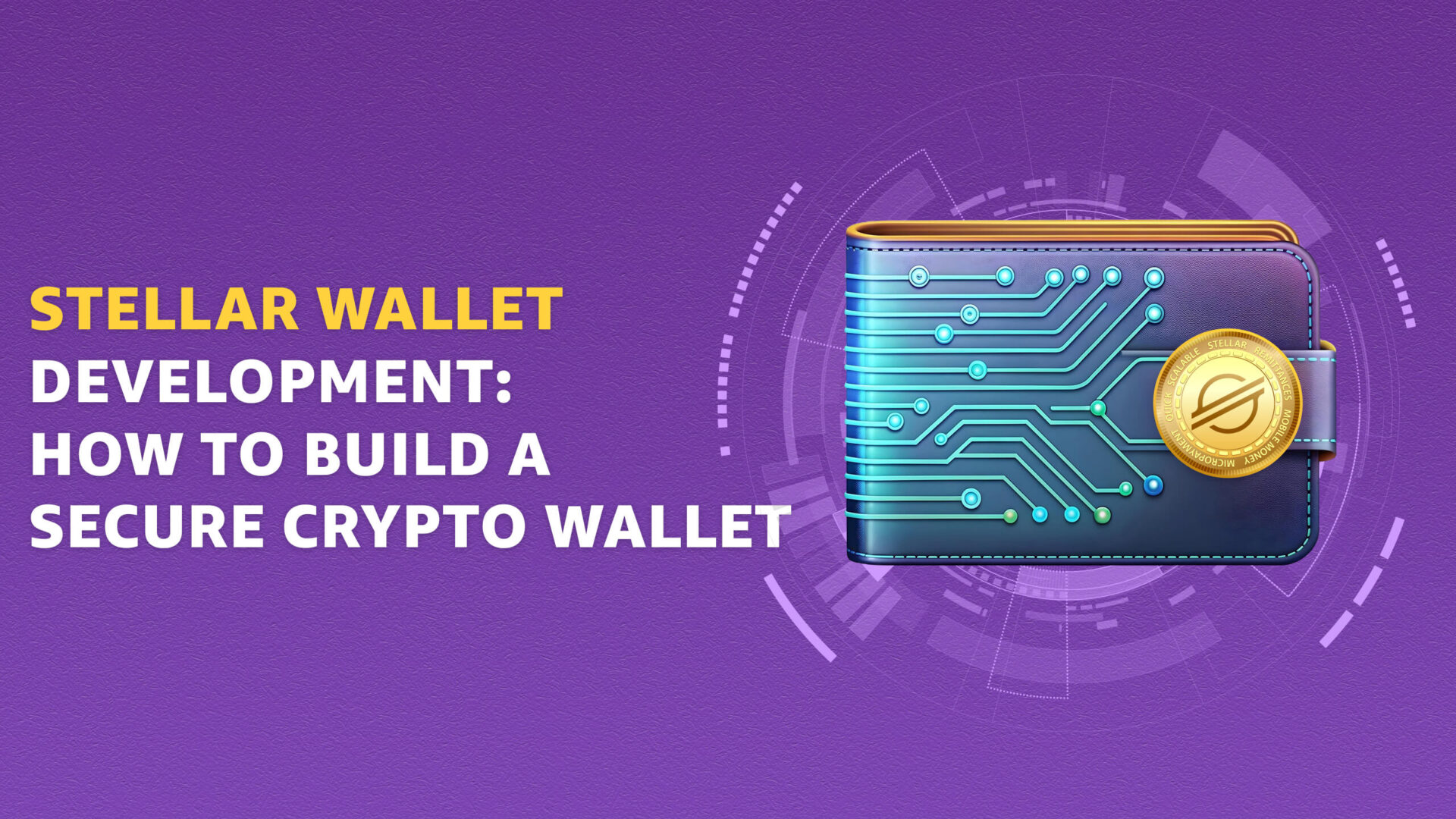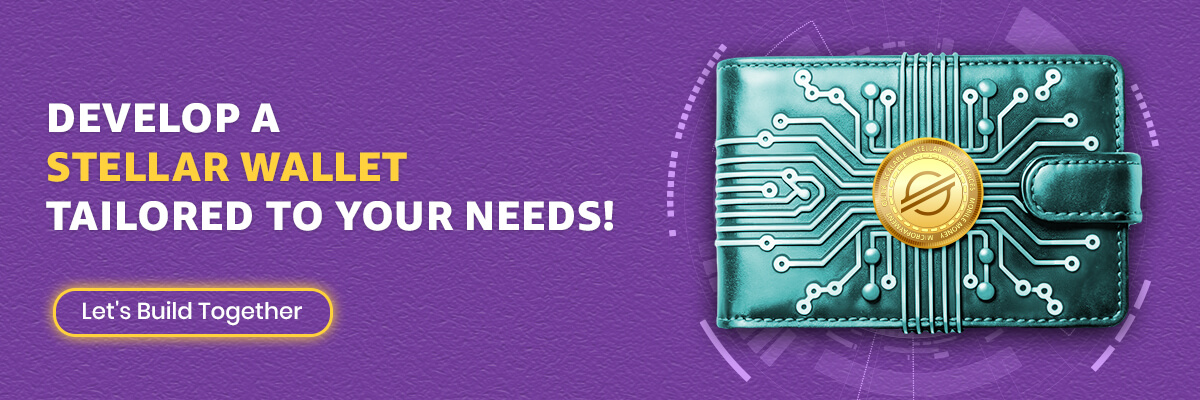With its growing popularity, Stellar blockchain has become the bridge between traditional financial rails and digital cryptocurrencies. Fostering the idea of financial inclusiveness and consensus protocol, it allows users to trade in both crypto tokens and fiat currencies from a centralized platform. The native token of Stellar, XLM, or Lumens, is also considered a great asset, allowing users to compensate for the transaction fee and minimum account balance needed to keep the same active. However, users will need a security vault to store and manage the native token, Lumens, which is where the concept of a Stellar wallet comes to the forefront.
Being a digital entity, it offers excellent security and end-to-end encryption of the tokens, providing sole control of the user’s funds and private keys. Owing to the increasing demand for such an advanced digital entity, it’s time you embark on a stellar wallet development project. It will not only add more weight to your Stellar-powered decentralized applications but also assist your end users in initiating transactions in Lumens without relying on a third-party wallet. However, developing the wallet is not a piece of cake that can be completed within minutes. With this being said, we have compiled a detailed guide about developing a Stellar wallet with state-of-the-art features.
Key Features to Develop For a Stellar Wallet
One of the key steps of the stellar wallet development project is deciding the digital entity’s features. To help you out with this, we have listed a few major characteristics that make the wallet different from other crypto wallets prevalent in the market.
1. Access To Native Tokens
The Stellar wallet should provide unhindered access to the native token of the Stellar global network, i.e., Lumens or XLM. In other words, users should be able to sell or purchase Lumens or use the same to pay the transaction fee without requiring any further currency conversion or tokenization.
2. Advanced Security Protocols
Maintaining optimal wallet security is imperative and non-negotiable. It should store the private keys in encrypted form so as to eliminate the risks of external vulnerabilities. Additionally, the wallet must be protected with a two-factor authentication system, password encryption, or fingerprint lock so that no one can access the digital tool apart from the account holder. Since Stellar Wallet will be deployed to its blockchain network, maintaining end-to-end immutability is mandatory.
3. Built-In Swapping Module
One of the most important features that should be integrated with the Stellar wallet is the built-in swapping module. It will allow users to directly convert their assets into crypto tokens without bearing exceptionally high transaction fees. Additionally, it will also help them cut losses, gain autonomous ownership of the asset, and build a strong investment portfolio in the decentralized finance ecosystem.
4. Direct Payment Compatibility
The Stellar wallet to be developed should be integrated with the financial rails of the credit card system, allowing users to purchase Lumens or tokenize a real-world asset directly. It would eliminate the dependencies on banking rails and direct payment gateways involved with the fiat currency.
5. Cross-Border Transactions
If the address of the payment receiver provided belongs to a different geographical location, the Stellar wallet shouldn’t put the transaction on hold. Cross-border transactions are one of the inherent features of the global Stellar blockchain. So, if the wallet needs to be deployed to this network, it should support cross-border transactions without depending on any third-party authenticator or governance body.
6. Anonymity
One of the prime features you should include in the Stellar wallet development project is anonymity. In other words, the wallet shouldn’t ask for the user’s KYC verification or identify authentication during transaction initiation. Instead, it should consider the series of random alphanumeric sequences generated to determine the parties involved in a single transaction.
Stellar Wallet Development with SDKs
The Stellar global network comes with a built-in SDK to allow professionals to develop excellent wallets with all the features we have mentioned above. Before you embark on the project, it’s important you know about the various integrations and Stellar Ecosystem Protocols available in the Stellar SDK for developing a state-of-the-art wallet.
1. Stellar Authentication
Firstly, the wallet needs to have specific keys through which user authentication and transaction verification can be processed without any hurdle. It is achieved by integrating the SEP-10 standard with the wallet. A single key can be used to authenticate the user and send funds to another user. However, developers need to divide the responsibilities to reduce external vulnerabilities of the key. Once the authentication keypair is generated using an anchor, it can be integrated further with the wallet.
2. Private Key Recovery
Stellar wallet is non-custodial, meaning it will protect the private keys without exposing them to any external threat. However, in situations where the user has lost the private key, the Stellar wallet needs to have a feature that can allow its recovery. It is basically done with the help of SEP-30 as it allows the user to recover the lost private keys through the Stellar account or wallet without handing over the autonomous control to any third-party entity.
3. Hosted Deposits And Withdrawals
One of the key components of your stellar wallet development project will be including the SEP-24 standards in your codebase to allow the wallet to interact with the pre-defined anchors. Once you define the standards, your wallet will automatically facilitate exchanges with Lumens (on-chain assets) along with fiat currencies and other crypto tokens (off-chain assets). Usually, the wallet will trigger numerous requests and once the anchor provides an interactive URL, it will provide access to the iframe. It is through this URL that the user will enter any input from the front end of the crypto application. Based on these inputs, the wallet will fetch all the transaction details through query endpoints.
4. Programmatic Deposit And Withdrawal
To facilitate the exchange of both off-chain and on-chain assets on the Stellar global network, you will need to implement the SEP-6 standards available in the Stellar SDK. Additionally, you can use a specialized anchor that will use the SEP-38 standards. It will allow the users to make deposits using non-equivalent assets, thereby acting as the bridge between multiple financial rails.
Step-by-Step Description For Creating a Stellar Wallet
- Choosing the wallet type: The first task that you need to do for the stellar wallet development project is choosing the wallet type. Since the Stellar global blockchain offers four major types of wallets, including hot, cold, custodial, and non-custodial, you need to decide which category will be most apt for your project objectives and goals.
- Project setup: Any development process requires a detailed project planning and evaluation. It will help you to clearly define the goals and objectives to be met through the Stellar wallet, like the maximum fund capping to be allowed for each transaction, the SEP standards to be included, the anchors through which communication can be established, and many more.
- Designing the popup model: The popup model will help in displaying additional information, like the transactions initiated, user confirmation, and user guidance. Including this in the wallet development plan is essential since it lays the cornerstone of the user interface.
- Key storage setup: Since maintaining optimal Stellar wallet security is imperative, you need to define an appropriate storage space for the private keys. These will act as the identifiers or authenticators to verify any transaction to be initiated using the native tokens or Lumens. Encryption of the keys is essential so as to protect them from external vulnerabilities.
- Event handling setup: Thanks to the API sets available in the Stellar SDK, you can leverage them to set up different events. These will act as triggers to generate accurate responses against different user actions, like clicks, transaction requests, and many more. Asynchronous programming and JavaScript will be required to set up the event-handling workflows within the Stellar wallet.
- Creating methods: As the Stellar wallet can be used for performing a wide range of functions, like exchanging Lumens or initiating payment transactions, you need to define separate methods for function handling and processing.
- Creating an account: The next step is to create a user profile on the Stellar global network. it will involve generating the public and private keys associated with your Stellar wallet, choosing an appropriate username for the account, and giving all the necessary information, including the KYC details for verification. Since the keys will provide you unhindered access to the Lumens and other crypto tokens stored in the wallet, encrypting and proper storage of these keys is imperative.
Conclusion
In this article, we have defined the entire process of stellar wallet development using various standards mentioned in the Stellar Ecosystem Protocols. Since the SDK is readily available, you won’t have any problem using the anchors to build a strong financial rail between the wallet and the external world. What’s more, you can leverage the developed Stellar wallet to execute transactions using native tokens, named Lumens and XLMs.





